Physical Address
304 North Cardinal St.
Dorchester Center, MA 02124
Physical Address
304 North Cardinal St.
Dorchester Center, MA 02124
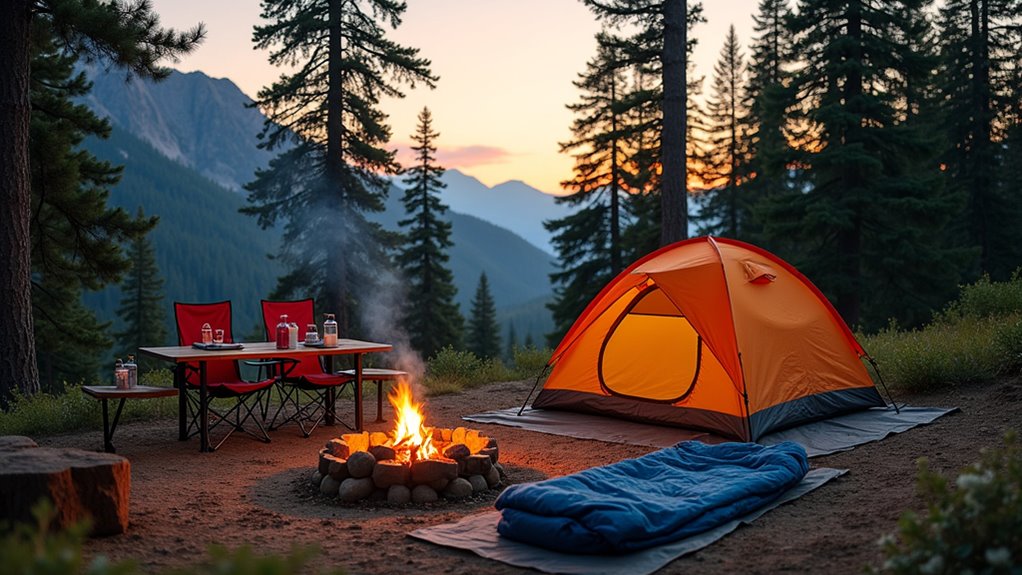
Jump into camping confidently with these 9 game-changing tips that turn nervous first-timers into outdoor enthusiasts who actually sleep well.
Are you ready to trade your comfortable bed for a sleeping bag under the stars? Planning your first camping trip can feel overwhelming when you’re staring at endless gear lists and conflicting advice online. You don’t need to become a wilderness expert overnight, but there are nine essential strategies that’ll transform your outdoor adventure from a potential disaster into an unforgettable experience. Master these fundamentals, and you’ll discover why millions of people can’t wait to escape civilization.

When you’re planning your first camping adventure, selecting a campsite that matches your experience level can make the difference between a memorable trip and a stressful ordeal. Start with established campgrounds that offer amenities like restrooms, potable water, and designated fire rings. These facilities provide safety nets while you’re learning basic camping skills.
Look for sites with level ground for easier tent setup and nearby parking for convenient gear access. Avoid remote backcountry locations or primitive sites that require advanced navigation and survival skills.
Check campground reviews online to gauge difficulty levels and read about other campers’ experiences.
Consider proximity to towns for emergency supplies and choose locations with cell service. State parks often strike the perfect balance between natural beauty and beginner-friendly infrastructure.
Before making your final decision, ask yourself the right questions about what camping style best suits your comfort level and outdoor goals.
The key to successful camping lies in bringing what you truly need while leaving unnecessary items at home. Start with shelter essentials: a reliable tent, sleeping bag rated for expected temperatures, and a sleeping pad for insulation. You’ll need a headlamp with extra batteries, basic first aid supplies, and weather-appropriate clothing layers.
Smart camping starts with shelter basics: quality tent, temperature-rated sleeping bag, insulating pad, reliable headlamp, first aid kit, and proper clothing layers.
For cooking, pack a portable stove, lightweight cookware, and non-perishable foods. Don’t forget water bottles or a filtration system, matches in waterproof containers, and basic tools like a multi-tool or knife.
Skip duplicate items and heavy luxuries. Instead of multiple jackets, bring one versatile layer. Choose multi-purpose gear whenever possible.
Pack everything the night before and do a final weight check—your fully loaded backpack shouldn’t exceed 20% of your body weight. Proper storage and drying of your camping gear after each trip helps prevent mildew growth that can damage equipment over time.
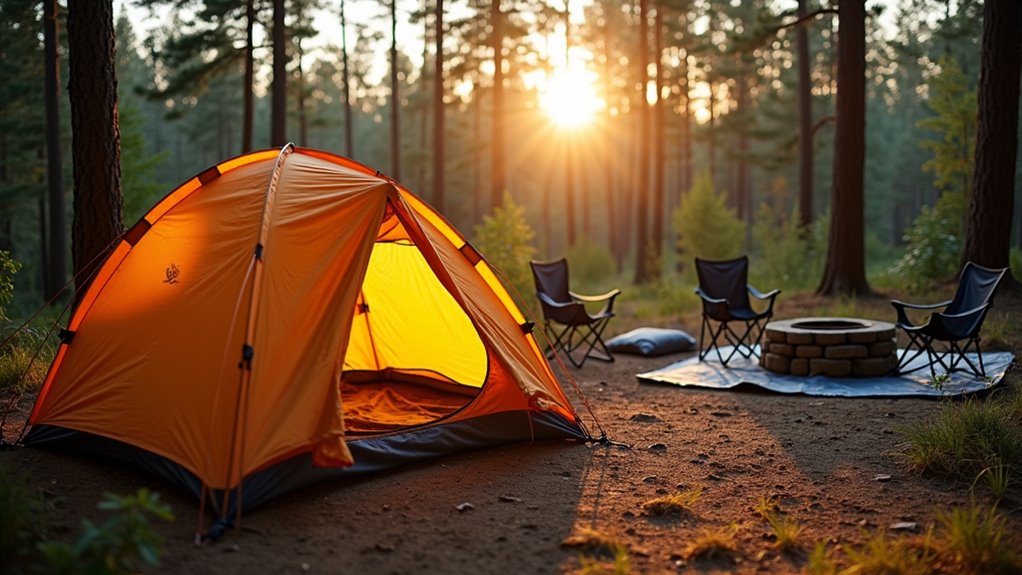
Arriving at your campsite with plenty of daylight remaining will save you from the frustration of fumbling with tent poles in darkness. Plan to reach your destination at least two hours before sunset to give yourself adequate setup time.
Start by surveying your campsite for the flattest, driest spot that’s away from dead branches overhead. Clear rocks, sticks, and debris from your tent area. Practice setting up your tent at home beforehand—you’ll thank yourself later when muscle memory kicks in.
Establish your camp layout strategically: position your tent upwind from the fire pit, keep your cooking area downwind, and place your food storage away from your sleeping area.
Set up your sleeping system completely before dark, including inflating your sleeping pad and unrolling your sleeping bag.
When evaluating potential tent locations, consider multiple factors including drainage patterns, wind protection, and proximity to water sources to ensure you’ve chosen the perfect campsite for a comfortable night’s rest.
Since camping meals require advance planning and can’t rely on last-minute grocery runs, you’ll want to map out every meal before you leave home. Write down breakfast, lunch, dinner, and snacks for each day, then create a detailed shopping list.
Choose foods that won’t spoil quickly and are easy to prepare over a campfire or portable stove. Pre-cook items like hard-boiled eggs or marinated chicken at home to save time and fuel.
Essential food storage items include:
Keep raw meat separate and maintain proper temperatures to prevent foodborne illness. If you’re planning to combine camping with rock climbing activities, pack high-energy snacks and extra water to fuel your adventures.
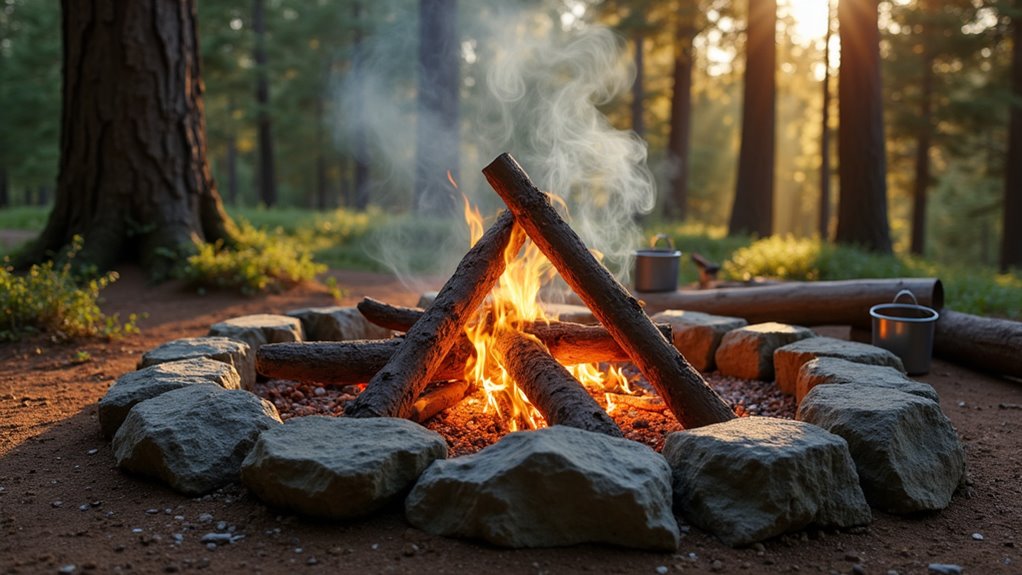
After you’ve planned your meals and secured proper food storage, building and maintaining a safe campfire becomes your next priority for cooking and warmth.
Check local fire restrictions before your trip, as many areas ban campfires during dry seasons. Choose existing fire rings when available, or create a circle with rocks on bare soil, clearing away flammable debris within ten feet.
Build your fire using the teepee method: place tinder in the center, surround it with kindling, then add larger logs in a cone shape.
Keep water and dirt nearby for emergencies. Never leave your fire unattended, and completely extinguish it before sleeping or leaving camp. Stir ashes, add water, and stir again until everything’s cold to touch.
For motorcycle camping adventures, pack compact fire-starting materials since space and weight are at a premium on your bike.
Weather conditions can shift dramatically in the outdoors, especially at higher elevations where temperatures drop 3-5 degrees for every 1,000 feet of elevation gain. You’ll want to pack layers and prepare for unexpected changes that can happen within hours.
Check the forecast before departing, but don’t rely on it completely. Mountain weather’s notoriously unpredictable.
Pack these essentials regardless of predictions:
Always bring more clothing than you think you’ll need. It’s better to carry extra weight than shiver through a miserable night or dangerous situation.
Whether you’re planning an extended adventure or a one day trip, weather preparedness remains crucial for your safety and comfort.
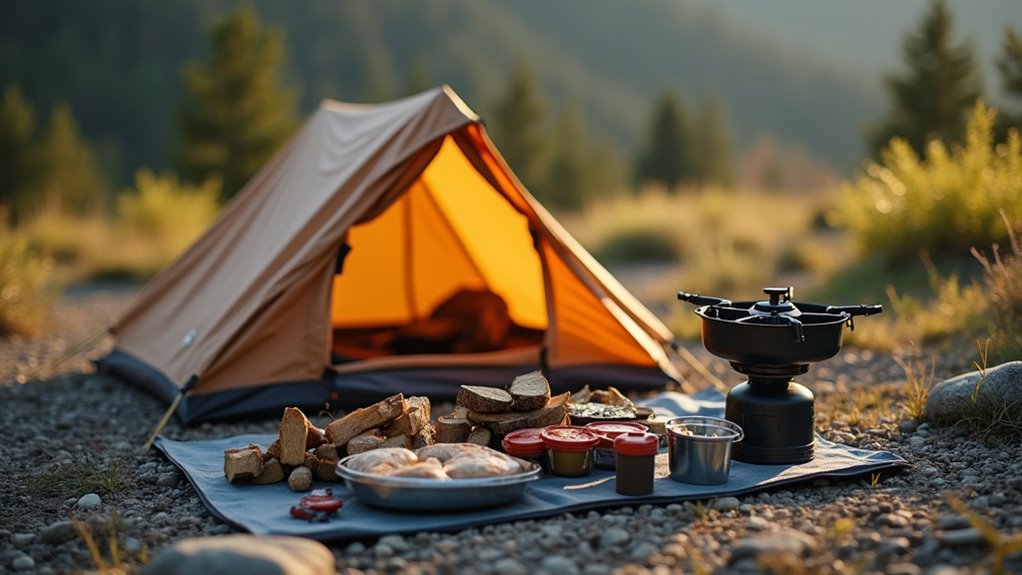
While you’re enjoying the great outdoors, you’ll want to preserve these natural spaces for future campers by following Leave No Trace principles. Pack out everything you bring in, including food scraps and trash.
Camp only in designated areas or on durable surfaces like rock or gravel to minimize impact. Keep campfires small and use established fire rings when available. Always extinguish fires completely with water, stirring ashes until cold.
Respect wildlife by storing food properly and observing animals from a distance. Stay on marked trails to prevent erosion and protect vegetation.
Use biodegradable soap for washing dishes, and dispose of gray water at least 200 feet from water sources. Leave natural objects like rocks and plants where you found them for others to discover.
The core principle of Leave No Trace is to ensure that when you move on from your campsite, you don’t leave anything behind that would indicate you were ever there.
Since temperatures can swing dramatically from scorching afternoons to frigid nights in the wilderness, you’ll need a strategic layering system rather than relying on a single heavy jacket.
Think of layering like building blocks you can add or remove as conditions change:
Pack clothes for the worst-case scenario, then layer down when it’s comfortable.
Cotton kills in wet conditions, so stick with synthetic fabrics and wool.
Whether you’re planning a trek through the Andes or local mountain ranges, proper layering becomes even more critical at higher elevations where weather conditions can be especially unpredictable.
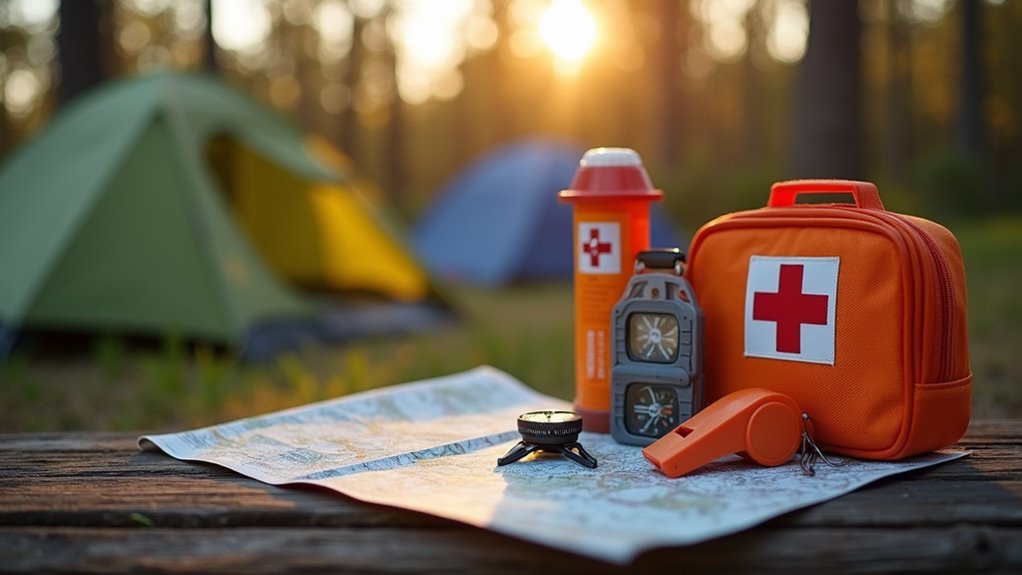
Even experienced outdoors enthusiasts can find themselves in unexpected situations, so you’ll want to establish a solid foundation of safety knowledge before heading into the wilderness.
Always inform someone about your camping location, planned activities, and expected return time.
Share your itinerary with a trusted contact before departing—include your destination, planned route, and when you expect to return home.
Pack a detailed first aid kit and learn basic wound care, including how to treat cuts, burns, and sprains.
Know the signs of hypothermia and heat exhaustion, and understand how to respond appropriately.
Familiarize yourself with local wildlife behavior and food storage requirements.
Keep emergency contact numbers accessible, including park rangers and local emergency services.
Practice using your whistle for signaling help—three sharp blasts is the universal distress signal.
Download offline maps to your phone as backup navigation.
Consider bringing a camping canopy to provide essential shelter from unexpected weather changes or to create a designated safe space at your campsite.
You’ve learned to choose smart campsites, pack essential gear, and set up before dark. You’ve mastered meal planning, fire safety, and weather preparation. You’ve committed to Leave No Trace principles, proper layering systems, and emergency protocols. Now it’s time to put these skills into practice. Trust your preparation, embrace the adventure, and remember that every experienced camper started exactly where you’re standing today. Get out there and create those unforgettable memories.